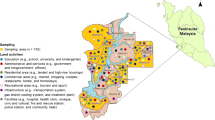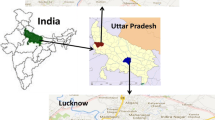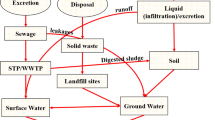Abstract
The occurrences of pharmaceuticals and personal care products as emerging organic contaminants (EOCs) have been reported in several countries of the world except from African countries. This study was therefore conducted to investigate the occurrence of nine antibiotics, five antipyretics, atenolol, bezafibrate, and caffeine in wastewater and surface water samples from the Umgeni River. The water samples were extracted with solid-phase extraction using hydrophilic-lipophilic balance (HLB) and C-18 cartridges for the acidic and neutral drugs, respectively. The quantification was carried out with high-performance liquid chromatography-diode array detector (HPLC-DAD) using the standard addition method. The method limits of detections were in the range of 0.14–0.97 μg/L while the recoveries were between 53.8 and 108.1 %. The wastewater had 100 % occurrence of the analytes studied, with caffeine having the highest concentration at 61 ± 5 μg/L and nalidixic acid being the most observed antibiotic at 31 ± 3 μg/L. The waste treatment process reduced the influent concentrations by 43.0–94.2 % before discharge except for atenolol removal that is lower. The concentrations of the analytes were lower in the surface water with most compounds having concentrations below 10 μg/L except acetaminophen and atenolol. The estuary mouth and Blue Lagoon had the highest concentrations of some of the compounds in surface water which depict downstream load. The factors governing the fate and mobility of these compounds in this environment are not fully understood yet and will require further studies.









Similar content being viewed by others
References
Aga, D. S. (Ed.). (2008). Fate of pharmaceuticals in the environment and in water treatment systems (p. 408). USA: CRC Press Taylor and Francis Group.
APHA - American Public Health Association (2005). Standard methods for the examination of water and wastewater, 21st ed. Washington, DC.
Benito-Pena, E., Partal-Rodera, A. I., Leon-Gonzalez, M. E., & Moreno-Bondi, M. C. (2006). Evaluation of mixed mode solid phase extraction cartridges for the preconcentration of beta-lactam antibiotics in wastewater using liquid chromatography with UV-DAD detection. Analytica Chimica Acta, 556, 415–422.
Benotti, M. J., Trenholm, R. A., Vanderford, B. J., Holady, J. C., Stanford, B. D., & Snyder, S. A. (2009). Pharmaceuticals and endocrine disrupting compounds in U.S. drinking water. Environmental Science and Technology, 43, 597–603.
Blackwell, P. A., Lützhøft, H. H., Ma, H. P., Halling-Sørensen, B., Boxall, A. B. A., & Kay, P. (2004). Ultrasonic extraction of veterinary antibiotics from soils and pig slurry with SPE clean-up and LC–UV and fluorescence detection. Talanta, 64, 1058–1064.
Bolong, N., Ismail, A. F., Salim, M. R., & Matsuura, T. (2009). A review of the effects of emerging contaminants in wastewater and options for their removal. Desalination, 239, 229–246.
Carucci, A., Cappai, G., & Piredda, M. (2006). Biodegradability and toxicity of pharmaceuticals in biological wastewater treatment plants. Journal of Environmental Science and Health Part A—Toxic/Hazardous Substances and Environmental Engineering, 41(9), 1831–1842.
Castiglioni, S., Bagnati, R., Calamari, D., Fanelli, R., & Zuccato, E. (2005). A multiresidue analytical method using solid-phase extraction and high-pressure liquid chromatography tandem mass spectrometry to measure pharmaceuticals of different therapeutic classes in urban wastewaters. Journal of Chromatography A, 1092, 206–215.
Celiz, M. D., Tso, J., & Aga, D. S. (2009). Pharmaceutical metabolites in the environmental: analytical challenges and ecological risks. Environmental Toxicology and Chemistry, 28, 2473–2484.
Department of Water Affairs and Forestry, South Africa – (DWAF) (2008). Resource management plan for Inanda Dam: Final Draft pp. 81 available online: http://www.dwaf.gov.za/Documents/Other/RMP/Inanda/InandaRMPJuly2008.pdf. Accessed August 16, 2013.
Dougherty, J. A., Swarzenski, P. W., Dinicola, R. S., & Reinhard, M. (2010). Occurrence of herbicides and pharmaceutical and personal care products in surface water and groundwater around Liberty Bay, Puget Sound, Washington. Journal of Environmental Quality, 39, 1173–1180.
Esrafili, A., Yamini, Y., & Shariati, S. (2007). Hollow fiber-based liquid phase microextraction combined with high-performance liquid chromatography for extraction and determination of some antidepressant drugs in biological fluids. Analytica Chimica Acta, 604, 127–133.
Fick, J., Soderstro, H., Lindberg, R. H., Phan, C., Tysklind, M., & Larsson, D. G. J. (2009). Contamination of surface, ground, and drinking water from pharmaceutical production. Environmental Toxicology and Chemistry, 28(12), 2522–2527.
Fraga, C. G., Prazen, B. J., & Synovec, R. E. (2000). Comprehensive two-dimensional gas chromatography and chemometrics for the high-speed quantitative analysis of aromatic isomers in a jet fuel using the standard addition method and an objective retention time alignment algorithm. Analytical Chemistry, 72, 4154–4162.
Glassmeyer, S. T., Kolpin, D. W., Furlong, E. T., Focazio, M. J. (2008). Environmental presence and persistence of pharmaceuticals: An overview. In Diana S. Aga (Ed.), In Fate of pharmaceuticals in the environmental and in water treatment systems (pp. 3–52). FL, USA: CRC Press Taylor and Francis Group.
Godfrey, E., Woessner, W. W., & Benotti, M. J. (2007). Pharmaceuticals in on-site sewage effluent and ground water, Western Montana. Ground Water, 45(3), 263–271.
Haggard, B. E., Galloway, J. M., Green, W. R., & Meyer, M. T. (2006). Pharmaceuticals and other organic chemicals in selected north-central and northwestern Arkansas streams. Journal of Environmental Quality, 35(4), 1078–1087.
Heberer, T. (2002a). Occurrence, fate, and removal of pharmaceutical residues in the aquatic environmental: a review of recent research data. Toxicology Letters, 131, 5–17.
Heberer, T. (2002b). Tracking persistent pharmaceutical residues from municipal sewage to drinking water. Journal of Hydrology, 266, 175–189.
Heberer, T., Mechlinkski, A., Fanck, B., Knappe, A., Massmann, G., Pekdeger, A., & Fritz, B. (2004). Field studies on the fate and transport of pharmaceutical residues in bank filtration. Ground Water Monitoring and Remediation, 24, 70–77.
Hirsch, R., Ternes, T. A., Haberer, K., Mehlich, A., Ballwanz, F., & Kratz, K. L. (1998). Determination of antibiotics in different water compartments via liquid chromatography-electrospray tandem mass spectrometry. Journal of Chromatography A, 518, 213–223.
Hirsch, R., Ternes, T. A., Haberer, K., & Kratz, K. L. (1999). Occurrence of antibiotics in the aquatic environment. Science of the Total Environment, 225, 109–118.
Holm, J. V., Rügge, K., Bjerg, P. L., & Christensen, H. (1995). Occurrence and distribution of pharmaceutical organic compounds in the groundwater down gradient of a landfill (Grindsted, Denmark). Environmental Science and Technology, 28, 1415–1420.
Kolpin, D. W., Furlong, E. T., Meyer, M. T., Thurman, E. M., Zaugg, S. D., Barber, L. B., & Buxton, H. T. (2002). Pharmaceuticals, hormones, and other organic wastewater contaminants in U.S. streams, 1999–2000: a national reconnaissance. Environmental Science and Technology, 36(6), 1202–1211.
Kümmerer, K. (2001). Drugs in the environmental: emission of drugs, diagnostic aids and disinfectants into wastewater by hospitals in relation to other sources—a review. Chemosphere, 45, 957–969.
Kümmerer, K. (2009). Antibiotics in the aquatic environment—a review – Part I. Chemosphere, 75, 417–434.
Labadie, P., & Hill, E. M. (2007). Analysis of estrogens in river sediments by liquid chromatography-electrospray ionization mass spectrometry. Journal of Chromatography A, 1141(2), 174–181.
Labadie, P., Cundy, A. B., Stone, K., Andrews, M., Valbonesi, S., & Hill, E. M. (2007). Evidence for the migration of steroidal estrogens through river bed sediments. Environmental Science and Technology, 41, 4299–4304.
Lapworth, D. J., Baran, N., Stuart, M. E., & Ward, R. S. (2012). Emerging organic contaminants in groundwater: a review of sources, fate and occurrence. Environmental Pollution, 163, 287–303.
Larsson, D. G., de Pedro, C., & Paxeus, N. (2007). Effluent from drug manufactures contains extremely high levels of pharmaceuticals. Journal of Hazardous Materials, 148, 751–755.
Li, J.-D., Cai, Y.-Q., Shi, Y. L., Mou, S. F., & Jiang, G. B. (2007). Determination of sulfonamide compounds in sewage and river by mixed hemimicelles solid-phase extraction prior to liquid chromatography–spectrophotometry. Journal of Chromatography A, 1139, 178–184.
Li, D., Yang, M., Hu, J., Ren, L., Zhang, Y., Chang, H., & Li, K. (2008). Determination and fate of oxytetracycline and related compounds in oxyteracycline production wastewater and the receiving river. Environmental Toxicology and Chemistry, 27, 80–86.
Li, D., Yu, T., Zhang, Y., Yang, M., Li, Z., Liu, M., & Qi, R. (2010). Antibiotic resistance characteristics of environmental bacteria from an oxytetracycline production wastewater treatment plant and the receiving river. Applied and Environmental Microbiology, 76(11), 3444–3451.
Lindqvist, N., Tuhkanen, T., & Kronberg, L. (2005). Occurrence of acidic pharmaceuticals in raw and treated sewages and in receiving waters. Water Research, 39, 2219–2228.
Löffler, D., & Ternes, T. A. (2003). Determination of acidic pharmaceuticals, antibiotics and ivermectin in river sediment using liquid chromatography–tandem mass spectrometry. Journal of Chromatography A, 1021, 133–144.
Loraine, G. A., & Pettigrove, M. E. (2006). Seasonal variations in concentrations of pharmaceuticals and personal care products in drinking water and reclaimed wastewater in Southern California. Environmental Science and Technology, 40(3), 687–695.
Miao, X. S., Bishay, F., Chen, M., & Metcalfe, C. D. (2004). Occurrence of antimicrobials in the final effluents of wastewater treatment plants in Canada. Environmental Science and Technology, 38, 3533–3541.
Murray, K. E., Thomas, S. M., & Bodour, A. A. (2010). Prioritizing research for trace pollutants and emerging contaminants in the freshwater environmental. Environmental Pollution, 158, 3462–3471.
Pal, A., Gin, A. Y.-C., & Reinhard, M. (2010). Impacts of emerging organic contaminants on fresh water resources: review of recent occurrences, sources, fate and effects. Science of the Total Environment, 408, 6062–6069.
Rabiet, M., Togola, A., Brissaud, F., Seidel, J. L., Budzinski, H., & Elbaz-Poulichet, F. (2006). Consequences of treated water recycling as regards pharmaceuticals and drugs in surface and ground waters of a medium-sized Mediterranean Catchment. Environmental Science and Technology, 40(17), 5282–5288.
Reyes-Contreras, C., Domínguez, C., & Bayona, J. M. (2012). Determination of nitrosamines and caffeine metabolites in wastewaters using gas chromatography mass spectrometry and ionic liquid stationary phases. Journal of Chromatography A, 1261, 164–170.
Rodil, R., Quintana, J. B., López-Mahía, P., Muniategui-Lorenzo, S., & Prada-Rodríguez, D. (2009). Multi-residue analytical method for the determination of emerging pollutants in water by solid-phase extraction and liquid chromatography–tandem mass spectrometry. Journal of Chromatography A, 1216, 2958–2969.
Schriks, M., Heringa, M. B., van der Kooi, M. M., de Voogt, P., & van Wezel, A. P. (2010). Toxicological relevance of emerging contaminants for drinking water quality. Water Research, 44(2), 461–476.
Soulides, D. A. (1965). Antibiotics in soils: Vii. Production of streptomycin and tetracyclines in soil. Soil Science, 100, 200–206.
Stockwell, V. O., & Duffy, B. (2012). Use of antibiotics in plant agriculture. Scientific and Technical Review of the Office International des Epizooties, 31(1), 199–210.
Swartz, C. H., Reddy, S., Benotti, M. J., Yin, H. F., Barber, L. B., Brownawell, B. J., & Rudel, R. A. (2006). Steroid estrogens, nonylphenolethoxylate metabolites, and other wastewater contaminants in groundwater affected by a residential septic system on Cape Cod, MA. Environmental Science and Technology, 40, 4894–4902.
Ternes, T. A. (1998). Occurrence of drugs in German sewage treatment plants and rivers. Water Research, 32(11), 3245–3260.
Ternes, T., Bonerz, M., & Schmidt, T. (2001). Determination of neutral pharmaceuticals in wastewater and rivers by liquid chromatography–electrospray tandem mass spectrometry. Journal of Chromatography A, 938, 175–185.
UIDP - Umgungundlovu IDP (2001). Phase one: Part 3 - Analysis report 7: environmental planning. KwaZulu-Natal Provincial Government. Available on: http://devplan.kzntl.gov.za/Municipal/IDPs/uMgungundlovu/Phase%201%20Analysis/uM%20%20Part%203%20Enviro nm ent%20SQ%207.doc. Accessed August 12, 2013.
Van der Zel. (1975). Umgeni River catchment analysis. Water SA, 1(2), 70.
Watanabe, N., Bergamaschi, B. A., Loftin, K. A., Meyer, M. T., & Harter, T. (2010). Use and environmental occurrence of antibiotics in free stall dairy farms with manure forage fields. Environmental Science and Technology, 44, 6591–6600.
Watkinson, A. J., Murby, E. J., Kolpin, D. W., & Costanzo, S. D. (2009). The occurrence of antibiotics in an urban watershed: from wastewater to drinking water. Science of the Total Environment, 407, 2711–2723.
Xie, Z., & Ebinghaus, R. (2008). Analytical methods for the determination of emerging organic contaminants in the atmosphere. Analytica Chimica Acta, 610, 156–178.
Yang, S., & Carlson, K. H. (2004). Solid-phase extraction-high-performance liquid chromatography-ion trap mass spectrometry for analysis of trace concentrations of macrolide antibiotics in natural and waste water matrices. Journal of Chromatography A, 1038(1–2), 141–155.
Acknowledgment
This work was funded by University of KwaZulu-Natal (UKZN) postdoctoral research grant. The authors also acknowledge the support of the Technical staff members of the UKZN School of Chemistry, Westville. The authors also acknowledge Redeemer’s University for postdoctoral research study leave.
Author information
Authors and Affiliations
Corresponding author
Rights and permissions
About this article
Cite this article
Agunbiade, F.O., Moodley, B. Pharmaceuticals as emerging organic contaminants in Umgeni River water system, KwaZulu-Natal, South Africa. Environ Monit Assess 186, 7273–7291 (2014). https://doi.org/10.1007/s10661-014-3926-z
Received:
Accepted:
Published:
Issue Date:
DOI: https://doi.org/10.1007/s10661-014-3926-z




